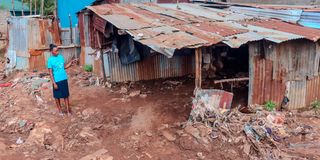Kibera’s forgotten residents battle floods amid looming evictions

Ms Martha Ayuya, a resident of Kibera in Niarobi, stands next to her house, which was destroyed by floods.
What you need to know:
- According to Habitat for Humanity Kenya, twist blocks are hollow, pre-cast concrete blocks that can be assembled without mortar, similar to legos.
- They are a cost-effective and time-efficient alternative to traditional construction methods.
Their future is bleak, their fate unknown. Hope is fading fast for Kibera residents, whose tenuous stake to the land that lies next to Nairobi Dam and Nairobi River, was painfully exposed by the recent flooding disaster after the government ordered them to pack their bags and leave the riparian corridor.
The swirling waters are ever menacing in their fierce and determined rush to reclaim nature’s space that was invaded by man in his attempt to make a living, raise a family and form a community.
Festus Muendo, the headteacher at New Hope Initiative Kibera, stares bleakly at the waterlogged neighbourhood, worried as much for the children under his care as for the massive investment he stands to lose should the evictions be effected.
“A mark put by officials from the Nairobi City County Government demarcating the riparian zone has affected part of the school’s playground, which means that, should it (the eviction order) be implemented, learners will have nowhere to play,” says Mr Muendo.
Construction of the 11 classrooms was completed last year, he says, adding that the school has 457 learners from Pre-primary One to Grade Eight.
“It cost us about Sh27 million to build the school and it is so disheartening to learn that it stands on riparian land,” Mr Muendo says.
The structure was put up by Start Somewhere, a construction company that uses twist blocks to mitigate losses caused by fire accidents, which Kibera is prone to.
According to Habitat for Humanity Kenya, twist blocks are hollow, pre-cast concrete blocks that can be assembled without mortar, similar to legos. They are a cost-effective and time-efficient alternative to traditional construction methods. Twist blocks are easy to use and can be assembled by unskilled labour.
“The technology was developed by a German architect. The aim was to build cheap but decent housing for locals who were accustomed to houses made from mud and corrugated iron sheets,” says Start Somewhere engineer Samson Ontweka.
Since 2018, the company has constructed schools and residential houses all over Kibera. According to Mr Ontweka, the houses are in demand due to the unique features that enable them to contain fire outbreaks. The blocks do not let air or water to penetrate through the joints, allowing them to regulate temperatures.
While the residential homes in the Mashimoni area are not on riparian land, Mr Ontweka says that one of their factories is next to Nairobi River while the other one is near the dam and adjacent to New Hope Initiative Kibera School.
“The heavy siltation had created space for locals to settle on but when it rained, the river reclaimed its space,” says Mr Ontweka.
While admitting to being knowledgeable about the law on riparian land, Mr Ontweka says the factory leased the land from a local organisation. “We are currently looking for a permanent place and we haven’t settled for one because we have to consider factors like accessibility and the riparian zone, which the government has set at at least 30 metres from the river on either side,” he says.
The two factories produce about 300 blocks a day and have a stock of 15,000 blocks valued at Sh2.8 million. He is concerned that if the government demolishes all the structures built on riparian land, the inventory will go up in smoke.
“We need at least a year to plan for the relocation of the factory. It takes quite a while to identify new land, acquire ownership documents, set up the machinery, and move the inventory to the new location,” he says.
Some residents in the Sokomoko area whose houses were near the river have been rendered homeless after the raging waters swept away their residences. Ms Martha Ayuya, 35, is currently being hosted by a friend. The mother of three says the flood waters forced her and her three children aged 18, 12, and five out of their house.
“All their birth certificates and school documents were destroyed alongside other household goods. I lost everything,” she laments.
Her neighbour, Mr Meshack Ngaira, who works as a security guard, says his monthly house rent was Sh1,500, but it has become impossible to get a rental house for the same amount. According to Ms Aisha Karanja, an environmentalist, these flood victims who are suffering silently should be accorded the same attention by the national government as those who are languishing in displacement camps.
Their leaking roofs that deny them sleep when it is raining, Ms Karanja points out, as well as the raw sewage that has found its way into their homes, disrupting their way of life, are both forms of internal displacement.
“Apart from the health risks, the disaster has taken a heavy toll on their emotional and mental health. If they don’t go to work, they will not get food and they cannot get help in the displacement camps," says Ms Karanja. Her sentiments are shared by Ms Jane Anyango, the national coordinator for Global Call to Action Against Poverty. She says the flood victims of Kibera have been forgotten.
“An immediate and effective response is critical. They should be compensated and given money to rent new homes. Their situation is dire,” she says.



